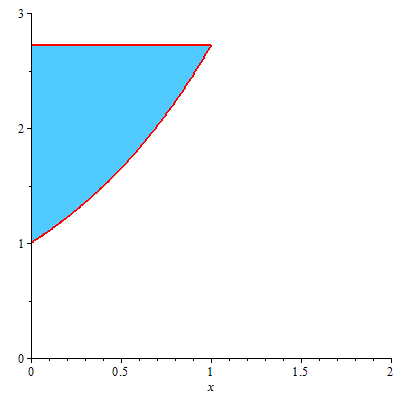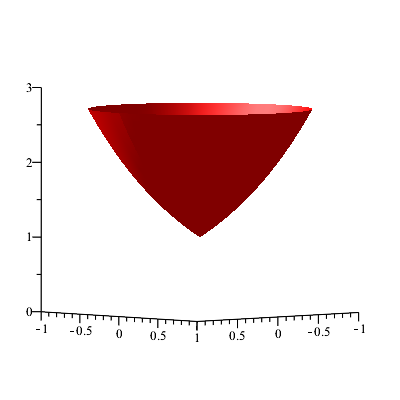Science:Math Exam Resources/Courses/MATH103/April 2011/Question 04 (b)
{{#incat:MER QGQ flag|{{#incat:MER QGH flag|{{#incat:MER QGS flag|}}}}}}
• Q1 (a) • Q1 (b) • Q1 (c) • Q2 (a) • Q2 (b) • Q2 (c) • Q2 (d) • Q3 (a) • Q3 (b) • Q4 (a) • Q4 (b) • Q5 (a) • Q5 (b) • Q5 (c) • Q5 (d) • Q6 (a) • Q6 (b) • Q7 (a) • Q7 (b) • Q7 (c) • Q8 •
Question 04 (b) |
|---|
|
Consider the function for 0 ≤ x ≤ 1. Find the volume of the bowl when rotating around the -axis. (Note: for this problem there are two ways to set the relevant integral up - either one is fine. One way involves rewriting as .) |
|
Make sure you understand the problem fully: What is the question asking you to do? Are there specific conditions or constraints that you should take note of? How will you know if your answer is correct from your work only? Can you rephrase the question in your own words in a way that makes sense to you? |
|
If you are stuck, check the hints below. Read the first one and consider it for a while. Does it give you a new idea on how to approach the problem? If so, try it! If after a while you are still stuck, go for the next hint. |
Hint 1 |
|---|
|
Draw a picture. Visualize the two ways of integrating as referred to in the hint. |
Hint 2 |
|---|
|
Write down two integrals that represent the volume of the solid. Which one would you prefer to evaluate? |
Hint 3 |
|---|
|
In this case, both integrals are possible to evaluate using the techniques that you've learned. It is a good reality check (and also a good exercise) to compute both integrals and ensure that you obtain the same result. |
|
Checking a solution serves two purposes: helping you if, after having used all the hints, you still are stuck on the problem; or if you have solved the problem and would like to check your work.
|
{{#incat:MER CT flag||
}}




















![{\displaystyle {\begin{aligned}V_{2}&=\pi \int _{1}^{e}(\ln y)^{2}\,dy\\&=\pi \left[\ln y(y\ln y-y)\right]_{1}^{e}-\pi \int _{1}^{e}{\frac {1}{y}}(y\ln y-y)\,dy\\&=\pi \left[1(e\cdot 1-e)-0\right]-\pi \int _{1}^{e}(\ln y-1)\,dy\\&=-\pi \left[y\ln y-y-y\right]_{1}^{e}\\&=-\pi \left[e\ln e-e-e-1\ln 1+1+1\right]\\&=-\pi \left(-e+2\right)\\&=\pi \left(e-2\right).\\\end{aligned}}}](https://wiki.ubc.ca/api/rest_v1/media/math/render/svg/198b19d32d9489bbd57f7b1a1fd7ed5d1298080c)









![{\displaystyle {\begin{aligned}V_{2}&=\int _{0}^{1}2\pi r(x)h(x)\,dx\\&=\int _{0}^{1}2\pi x(e-e^{x})\,dx\\&=2\pi e\int _{0}^{1}x\,dx-2\pi \int _{0}^{1}xe^{x}\,dx\\&=2\pi e\left[{\frac {x^{2}}{2}}\right]_{0}^{1}-2\pi \left(\left[xe^{x}\right]_{0}^{1}-\int _{0}^{1}e^{x}\,dx\right)\\&=2\pi e{\frac {1}{2}}-2\pi \left(e-\left[e^{x}\right]_{0}^{1}\right)\\&=\pi e-2\pi \left(e-(e-1)\right)\\&=\pi e-2\pi \\&=\pi (e-2).\end{aligned}}}](https://wiki.ubc.ca/api/rest_v1/media/math/render/svg/8dcd8859efb8bc7e37954d4d7f5ec7af74f564ed)
